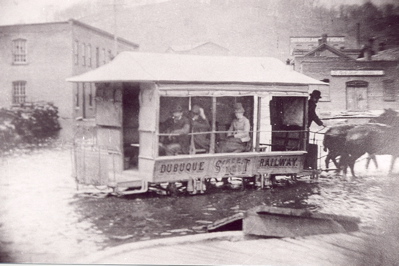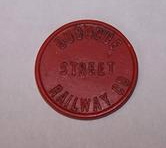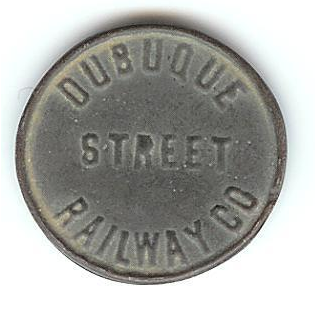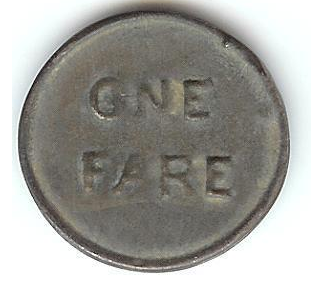Encyclopedia Dubuque
"Encyclopedia Dubuque is the online authority for all things Dubuque, written by the people who know the city best.”
Marshall Cohen—researcher and producer, CNN
Affiliated with the Local History Network of the State Historical Society of Iowa, and the Iowa Museum Association.
DUBUQUE STREET RAILWAY COMPANY: Difference between revisions
No edit summary |
No edit summary |
||
| Line 1: | Line 1: | ||
[[Image:streetrailway.jpg|left|thumb|300px|Photo courtesy: Bob Reding]] | [[Image:streetrailway.jpg|left|thumb|300px|Photo courtesy: Bob Reding]] | ||
[[Image:imp245.jpg|right|thumb|150px|Photo courtesy: Bob Reding]]DUBUQUE STREET RAILWAY COMPANY. Organized on October 1, 1867, the company listed among its officers [[SMITH, Platt|Platt SMITH]], [[GRAVES, Julius K.|Julius K. GRAVES]], [[STOUT, Henry L.|Henry L. STOUT]], and [[THOMPSON, John|John THOMPSON]]. With capitalization at $75,000, contracts for building and supplying the route were signed with Charles Hathaway of Philadelphia, Pennsylvania. Work on the route began on November 17. | [[Image:imp245.jpg|right|thumb|150px|Photo courtesy: Bob Reding]]DUBUQUE STREET RAILWAY COMPANY. | ||
Organized on October 1, 1867, the company listed among its officers [[SMITH, Platt|Platt SMITH]], [[GRAVES, Julius K.|Julius K. GRAVES]], [[STOUT, Henry L.|Henry L. STOUT]], and [[THOMPSON, John|John THOMPSON]]. With capitalization at $75,000, contracts for building and supplying the route were signed with Charles Hathaway of Philadelphia, Pennsylvania. Work on the route began on November 17. | |||
The first [[STREETCARS]] ran from the southern terminus of the ferry landing below Jones Street to Main and then north along Main to Thirteenth, to Clay, Eighteenth, and Couler Avenue. Continuing northward, the route ended at the fair grounds. Five cars began operations on May 23, 1868, with fifteen horses. | The first [[STREETCARS]] ran from the southern terminus of the ferry landing below Jones Street to Main and then north along Main to Thirteenth, to Clay, Eighteenth, and Couler Avenue. Continuing northward, the route ended at the fair grounds. Five cars began operations on May 23, 1868, with fifteen horses. | ||
Revision as of 03:33, 8 March 2012
DUBUQUE STREET RAILWAY COMPANY.
Organized on October 1, 1867, the company listed among its officers Platt SMITH, Julius K. GRAVES, Henry L. STOUT, and John THOMPSON. With capitalization at $75,000, contracts for building and supplying the route were signed with Charles Hathaway of Philadelphia, Pennsylvania. Work on the route began on November 17.
The first STREETCARS ran from the southern terminus of the ferry landing below Jones Street to Main and then north along Main to Thirteenth, to Clay, Eighteenth, and Couler Avenue. Continuing northward, the route ended at the fair grounds. Five cars began operations on May 23, 1868, with fifteen horses.
The Company was leased to Platt Smith and James Hughes until 1876 when Joseph H. RHOMBERG, John J. LINEHAN, and Bart E. LINEHAN purchased the franchise and reduced the fare from ten cents to a nickel. Conductors on the cars were paid forty-five dollars per month. The cars, later equipped with storage batteries, ran their route so frequently that they passed each other every five minutes. A round trip took one hour.
In February 1892 J. A. Rhomberg purchased the one-half interest in the Dubuque Street Railway company owned by Mrs. J. J. Linehan for $142,000. The car equipment of the new company was stated to be fifteen motor cars and ten new trailers. Each trailer would seat thirty people. The nine cars then equipped with storage batteries would be used on the overhead system without the storage batteries. A 350 horse power Corliss engine and a boiler of 100 horse power would be added to the power house which already contained a new Corliss engine of 725 horse power and two boilers each of 100 horse power. The storage battery cars were fourteen feet long. The overhead cars would be sixteen feet in length.
The trolley wire was to be stretched in three directions. One would extend from the power house to the levee. Another would run along Clay Street and Rhomberg Avenue. The third would reach from the power house to the northern terminus of the line.
Rhomberg stated at the time of the purchase that he overhead system and power plant would be operating within sixty days.







